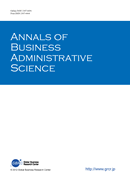
- Issue 6 Pages 251-
- Issue 5 Pages 199-
- Issue 4 Pages 163-
- Issue 3 Pages 119-
- Issue 2 Pages 59-
- Issue 1 Pages 1-
- |<
- <
- 1
- >
- >|
-
An Office Move CaseNobuyuki INAMIZU2016Volume 15Issue 5 Pages 199-209
Published: October 15, 2016
Released on J-STAGE: October 15, 2016
Advance online publication: September 27, 2016JOURNAL OPEN ACCESSThis study conducted a questionnaire survey of all employees at a company that moved its office location, both before and after the move. Results of the survey showed that while work environment satisfaction rose significantly because of the office move, there was no significant change in job satisfaction (in fact, some deterioration was observed). In addition, there was no significant change in the perspective index, which is regarded as a factor in job satisfaction, after the move. Existing studies on offices have asserted that job satisfaction increases along with work environment satisfaction. These results, however, made it difficult to posit such simple causation, showing the need for further testing and consideration.
View full abstractDownload PDF (284K) -
Shohei HAMAMATSU2016Volume 15Issue 5 Pages 211-220
Published: October 15, 2016
Released on J-STAGE: October 15, 2016
Advance online publication: September 30, 2016JOURNAL OPEN ACCESSIn response to arguments on the hollowing out of industries whereby an expansion in overseas production causes decreased domestic production, recent studies, primarily in the field of international economics, have pointed out the increase in domestic production due to an expansion in overseas production. Regarding specific mechanisms, Amano (2000) emphasized that when large companies with abundant management resources expand their overseas production, their spontaneous and induced conversion behaviors cause an increase in domestic production. Responding to this assertion, on the basis of case studies on small- and medium-sized enterprises (SMEs) with few management resources, this paper discovered a mechanism in which abundant management resources are not assumed. This mechanism was observed in the automotive parts industry in Japan, which faces difficulties in acquiring new customers because of fixed relationships. In this industry, it is possible to acquire new customers domestically through torihiki-jisseki (“track record of transactions” in Japanese) when overseas manufacturing sites conduct business with new customers. However, this strategy is a paradox for SMEs in Japan that wish to grow and survive domestically since it advocates overseas expansion rather than domestic expansion.
View full abstractDownload PDF (258K) -
Beyond EnglishizationHeejin KIM2016Volume 15Issue 5 Pages 221-237
Published: October 15, 2016
Released on J-STAGE: October 15, 2016
Advance online publication: October 12, 2016JOURNAL OPEN ACCESSThis paper reviews existing studies on the language strategies of multinational corporations (MNCs)—a subject that has received increasing attention since the late 2000s. In most of these existing studies, both academics and practitioners have tended to focus primarily on Englishization. That is, English as a lingua franca has been taken for granted, and most related studies have discussed organizational problems caused by Englishization and the solutions to those problems. However, English as a lingua franca is only one of various options, and it is incorrect to conclude that MNCs’ available language strategies are limited to Englishization. Instead, existing studies on language strategy take more multi-faceted perspectives and propose bilingual or multilingual strategies, choosing the term “language strategy” because of the increased emphasis on these various options.
View full abstractDownload PDF (249K) -
Jing-Ming SHIU, Masanori YASUMOTO2016Volume 15Issue 5 Pages 239-250
Published: October 15, 2016
Released on J-STAGE: October 16, 2016
JOURNAL OPEN ACCESSThe open source community (OSC) is a place to develop collective knowledge available to anyone, thereby inevitably engendering free riders. Despite this, many firms have contributed to OSCs. This study examines 10 Android smartphone manufacturers between 2010 and 2013 with regard to their (a) source code contributions and the relation of those contributions to (b) time to market as measured by the release of their first Android smartphones. The results of the analysis are divided into the following two groups: (A) a group that released smartphones faster than their competitors through source code contributions and (B) a group that made few source code contributions and was slower to release smartphones than group (A). In addition, in a few years, some firms were observed to have move from group (B) to group (A).
View full abstractDownload PDF (339K)
- |<
- <
- 1
- >
- >|